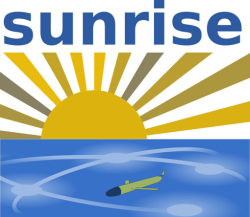
SUNRISE is a European robotics project involving the research and development of acoustic based networks to support sub-surface communications. Their aim is to eventually develop teams of mobile, autonomous aquatic robots that can interact and cooperate during assignments using SWARM Technology. The project is coordinated by Prof. Chiara Petrioli of the University of Rome “La Sapienza”, Italy.
The most difficult challenge in perfecting the SUNRISE project is establishing an effective way of communicating underwater. Radio waves work well above the surface, but not below, because the salty seawater absorbs and diffuses radio waves. Instead, the researchers behind SUNRISE took inspiration from whales and dolphins and have turned to sounds frequencies for their communication needs.
Eventhough underwater communication with low bandwith is still a problem, and under particular oceanographic conditions even impossible, the team of SUNRISE is positive.
On this issue, Prof. Chiara Petrioli said the following: "Low bandwidth is indeed an issue. We are designing approaches which can exploit at best different communication technologies when available, as this can increase data rates.
As for unreliability: that is true when considering a single link. However the challenge is to design a system which is reliable as a whole even if single elements or single links are not. This is one of the challenges addressed within the project, with first significant successes."
The communication system, named the “Internet of Underwater Things”, is the first of its kind. Already SUNRISE robots were able to successfully communicate and work together to find a lost cargo container in Porto, Portugal. This technology is groundbreaking and could open the door for all kinds of innovation.
During their missions, the location of each robot, as well as the temperature and chemical composition of the water and any other data it is collecting, is sent in real-time to a command center. This command center is then able to give feedback and directions.
The robots are not remotely controlled but work mostly autonomously using Swarm technology and respond to simple directions such as “Move from Point A to Point B”. If the robots are on the surface they receive their instructions via conventional radio signals, when submerged via sound waves.
Project SUNRISE - Video: Euronews
SUNRISE has set up a series of testbeds around the world to record the acoustic activity in different underwater environments. This will help them perfect SUNRISE’s communication system. These testbeds are located in the Atlantic Ocean, the Mediterranean, the Black Sea, and many lakes and canals across 6 different countries: the Netherlands, Portugal, Italy, Germany, Turkey, and the United States.
SUNRISE is funded by the European Commission under the 7th Framework Programme.